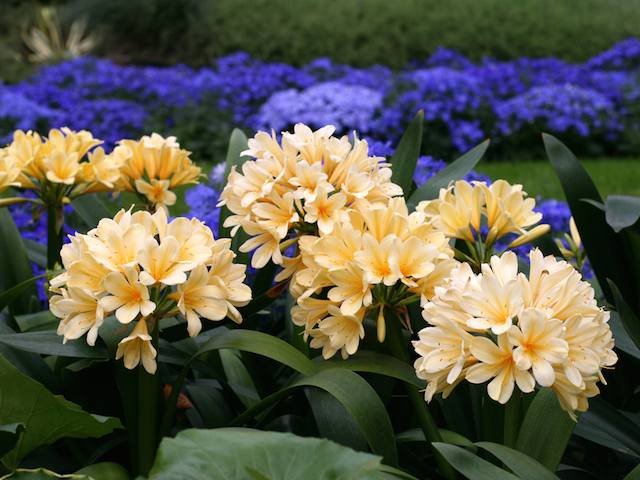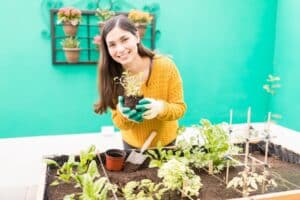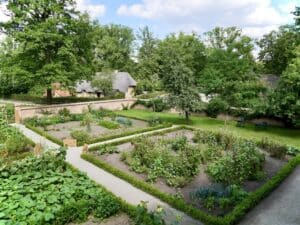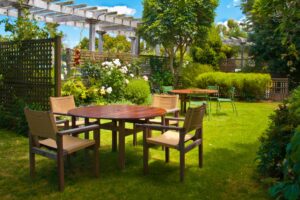A Comprehensive Guide to Garden Basics: Soil, Water and Sunshine

Growing a beautiful garden takes a little bit of hard work and plenty of love and care.
Yet there are three things that are easily the most important factors if you want your garden to do well, and you probably already know what they are. Water, Soil and Sunshine, the three most basic needs of every single plant on earth.
If you can master these basics, you’ll become a wise gardening pro in no time at all. We’ll talk a bit about how these 3 basic needs interact for plants, and the best combinations for some of the most popular plant types out there.
Then we’ll go through each one of these basics – watering, soil and sunlight – in a bit more detail, and include some links to our other guides on these topics. Get those green thumbs ready – let’s get into it!
Finding the perfect balance
Water, soil and sunlight might seem like independent needs for a plant. Yet these three forces all interact to provide nutrients for the plant via photosynthesis. That’s why it’s so important to try and strike the right balance between the three.
For instance, a plant that needs a lot of watering usually requires fast-draining soil as well, so that it doesn’t become waterlogged and drown. Similarly, a full-shade plant might need to be watered less frequently, as the water won’t evaporate as fast. Conversely, a full sun plant will dry out more quickly and may need more nutritious soil and regular watering.
Understanding these relationships and striking that balance is crucial to the success of your garden. When you’re choosing your next plant, take some extra time to think about whether your garden can really support the right combination of water, soil and sunlight for that particular species. If not, consider some changes (i.e. new soil) that you may need to make.
Thankfully, plants are pretty good at letting us know when things aren’t perfect. Wilting leaves, discolouration or a thin & stretching appearance are all signs that at least one need isn’t being met properly. If your plant is green and robust with strong growth, you’ll know that you’ve found the right balance.
Water, soil and sunlight for different plant varieties.
Finding that perfect balance for your garden might seem like one of those things that’s easier said than done. Yet it can start to feel simpler once you do some research into the different kinds of plants or gardens that you want. Grouping plants with similar needs together is another way to make this whole process a lot easier.
To get you started, we’ve included the best sun/water/soil combinations for some of the most popular plant varieties and garden styles. Check them out below:
—-
1. Succulents
Succulents can be kept indoors or outdoors and love the sun. They enjoy up to 6hrs of bright, indirect sunlight a day. If grown outdoors, succulents will still need a bit of shelter from the hot afternoon sun, especially in summer. Consider this when placing your succulents.
Water your succulents around once a fortnight, and as little as once a month during winter. Always check the soil is fully dry before watering again. These plants have shallow roots and enjoy loose, nutrient-rich soil that is sandy or rocky and drains quickly.
2. Box Hedges
Box or ‘Buxus’ plants are a hardy group of hedges that can survive in many different environments. They prefer full sun and sandy or rich composted soil, with plenty of humus and a pH level of around 6.5 – 7.5. (Meaning ‘Neutral’ or ‘Alkaline’ Soil is fine)
A Box Hedge will need one to two deep waterings a week at first, though it will gradually need less watering as it matures. It’s worth noting that many Buxus plants are tough, and have been known to grow even in full shade, drought conditions and a hard clay soil!
3. Australian Natives
Australian Native Gardens are a great choice as they can withstand harsh conditions. Many native plants can flourish in sandy or clay soils that are otherwise weak and nutrient-poor. They can also endure periods without water and handle harsh full sun with little trouble.
Keep in mind, however, that Australia is a big country with many different climates. For instance, plants from the Australian rainforest will need full or partial shade, richly composted soil and plenty of moisture. You can read more about Australian Native Gardens on our blog.
4. Vegetable Gardens
Veggie Gardens are another popular garden type with a lot of variations between plants, but there are still some good guidelines that apply to most veggies. Rich, composted soil with lots of organic matter is important, as is plenty of regular watering and good drainage.
Different veggies will have different sunlight requirements. Root vegetables prefer a partial sun environment, whereas fruit-producing vegetables like tomato and cucumber love full sunlight. Check out our seasonal guides – like Winter Veggies or Autumn Veggies – for more.
5. Grasses and Strappy Plants
Grasses and Strappy Plants are the unsung heroes of gardens. These hardy little plants fill difficult spaces and add texture. Most ornamental grasses tend to prefer full sun and slightly moist soil with free-flowing drainage. However, they will tend to survive in most conditions.
Unlike lawn grasses, ornamental grasses and strappy plants are drought-hardy and don’t require too much water. In fact, they’re a great low-maintenance plant. One thing to remember is that they do best with a little bit of space, so don’t crowd them too much!
—-
Plants are unique little things, so each of these categories may contain a couple of plants with needs that differ from those above. Generally, however, these guidelines are great rules of thumb to follow for the above plant varieties.
If you’re interested in learning more, keep reading as we go more in-depth on what you should know about watering, soil and sunlight for your new garden.
A Guide to Watering your Garden
Water is life for plants. Like humans, plants are made up almost entirely of water. It’s what fills their cell structures and gives plants their unique, vibrant shapes. Without water, these cells will start to sag and die – leaving you with a very sad-looking plant.
Luckily, it’s easy to tell when your garden needs a drink. A thirsty plant will look droopy and may start to brown or curl at the edges. The catch is that this may also be due to overwatering, which is unfortunately a very common issue.
Every plant in your garden is going to have different watering needs, and a little trial and error is totally normal and to be expected. But still, knowing a bit more about the basics of watering your garden will help you avoid some of the most common pitfalls.
Always check the soil moisture first
This is the easiest and most foolproof way to see whether it’s time to water your garden. In fact, you’ll find this simple piece of advice all through our website – it’s basically the golden rule of gardening.
Simply stick your fingers a few centimetres in the soil, or take some between your fingers and squeeze it to see if it sticks to you. Ideally, the soil should be slightly moist. If it’s soaking wet and you haven’t watered recently, you may be overwatering or have a drainage issue.
If the soil is crumbly and dry, then that means it’s time to water your plants. One thing to remember is that the type of soil you’re using (i.e. clay) can also make a difference – we’ll talk more about this when we talk about choosing a garden soil.
Morning is the best time of day to water your garden
Generally, the morning is always the best time to water your plants. There are a number of advantages to this. Firstly, it will give the plants more time to absorb the water and convert it into energy as the sun heats up and kick-starts the photosynthesis process.
Watering earlier in the day will also give water in the soil more time to naturally evaporate, as soil that is watered in the evening can retain a lot of moisture on a cold night. This is especially important to consider for garden beds that don’t have a lot of drainage.
Seasonal watering – watch out for the weather!
Watering your garden won’t be the same all year round. Many plants – like the Fiddle Leaf Fig – prefer to be watered less frequently in winter as they ‘rest’ and use less energy. Water also takes longer to evaporate in these colder temperatures. The reverse is true for summer, and your plants may need more water to keep up with drying out in the heat.
Keep the rain in mind too, especially for gardens that are completely out in the open. This is the natural way for plants to drink and, most of the time, it will be more than enough hydration for them. The weather forecast always gets the last word when it comes to your watering schedule.
Some other quick tips for watering your garden.
There are a couple of other little things that are great to keep in mind. One is to always water the base of your plants, not the leaves. Surface-level watering can cause shallow, weak roots. The deeper the water gets into the soil, the healthier your root system is going to be.
Also, watch out for the salinity of your tap water. Softened water (like the kind we get in Melbourne & Victoria) is treated with sodium, which can build up in your soil. You can flush this out occasionally with a heavy watering, sometimes called a ‘Leaching’.
Finally, consider the best way to water. A hose or a watering can is a simple solution, but you might start thinking about sprinklers and irrigation as your garden starts to grow! It’s worth it to play around and find out what works – but you can always ask one of our garden experts for help if you need!
If you want some more information, you can check out our other watering guides:
A Guide to Gardening Soil.
Soil is another crucial ingredient to a successful garden, but it doesn’t always get the same amount of attention that water and sunlight do. There’s a reason that there are so many different types of potting soil out there – plants won’t make it just anywhere.
This is because the plants in our gardens tend to come from all over the world. It figures that they all have slightly different ideas about what makes for a comfortable home. Some plants prefer rich and moist soil, while others may prefer dry, gritty sand.
It pays to do a bit of research first, as not all plants will live side by side in the same soil. But don’t fret – choosing the right soil is easy once you understand the basics.
The three types of soil
There are roughly 3 basic types of soil available. Some may tell you there are as many as 9 or 10, depending on how technical you want to get! However, understanding these 3 is usually good enough to get started.
- Sandy Soil is loose, gritty and will fall apart in your hand. It drains very fast.
- Clay Soil is tightly packed and firm. It holds water easily and doesn’t drain well.
- Rich Composted Soil is nutrient-rich and contains organic matter (i.e. compost). It’s loamy and drains just right. It combines the qualities of these 3 soils and should crumble gently in your hand when touched.
Most garden plants prefer a rich composted soil, though plants from different environments may have different tastes. Soil composition (i.e. what’s in your dirt) can vary a lot in quite a small area, so it’s impossible to know exactly what you have in your suburban backyard until you check.
For this reason, it’s usually wise to enrich the soil in your garden beds with a formulated potting mix that suits your plants, at least to the depth at which you will plant your garden. This is what most gardeners do – you can browse our range of potting mixes here.
Soil Acidity
Soil Acidity isn’t important to every plant, but for some, it is absolutely essential. The acidity of soil affects the availability of the nutrients that your plants need. Plants that love acidic soil may suffer nutrient deficiencies if they are placed in alkaline or neutral soil.
Soil acidity is measured on a pH scale. One thing to remember about this scale is that it counts backwards. A pH of 7 is neutral, and anything above 7pH is considered Alkaline. Soil with a pH of 6 or less is acidic. The lower the number, the more acidic the soil.
Soil acidity is some scientifically technical stuff, and there are no quick fixes to change your soil pH to make it more or less acidic, though you can achieve it over time. If you’re interested, you can read more about Soil Acidity here.
Soil Drainage
Finally, you want to make sure your soil drains well. If your soil is retaining too much moisture, your plants may end up drowning. Try to choose soil that lets water pass through it easily to prevent this from happening.
Soils with lots of clay in the composition may clump together and struggle with draining. You can improve the drainage of your soil by adding plenty of organic matter, like compost, manure, mulch or shredded plant matter.
A Guide to Sunlight for Gardens
Finally, sunlight is another essential, basic need for your garden. It’s the key ingredient in photosynthesis, the process that plants use to convert sunlight into energy.
Plants are very clever little things, and his incredible scientific process is how plants sustain their constant growth. You can read about photosynthesis in more detail in one of our other guides to sunlight – Sunlight: How much do plants need?
Unlike with soil and water, you don’t have much control over the sun in the sky. Instead, you need to be smart about where you decide to place your garden (or gardens!).
However, having a bit more knowledge and understanding about sunlight will make these decisions feel much less daunting. Let’s get into it in a bit more detail:
The different kinds of sunlight for gardens.
When it comes to gardens, there are three types of sunlight out there. Different types of plants will have different sunlight preferences, depending on the climate of the natural environment that they originally come from.
You’ll find that all of the plants in our online garden store, and in garden stores everywhere, are organised into these three categories. This makes it much easier to group your plants and plan where they’ll go in order to get their preferred amount of sunlight.
1. Full Sunlight
Full sun is the kind of sun you get in the middle of the day and the afternoon, when the sunlight is as hot and bright as it’s going to get. Generally, plants that love full sun are more heat and drought-resistant, which makes them well suited to the harsh extremes of Australian summers.
For those living in Melbourne and Geelong, where our garden stores are located, we recommend giving your full sunlight plants around 6-8 hours a day. Outdoor garden plants that love full sun include Ficus flash, Magnolia, Citrus and Fruit trees and Succulents.
2. Partial Sun & Shade
Many garden plants prefer a mix of both sun and shade. The hot afternoon sun will generally be too extreme for plants that prefer these temperate conditions. On the other hand, the full shade will not give them enough sunlight to thrive.
Instead, a few hours of the cooler morning sun is perfect for these kinds of gardens. We recommend placing sun & shade gardens so that they are facing the morning sun or receiving indirect light, but are firmly shaded in the afternoons.
You’ll find many plants enjoy this kind of mixed or indirect sunlight. Popular partial sun & shade plants include Azaleas, Japanese Maples, Camellias, Gardenias and Birds of Paradise.
3. Full Shade.
You might be surprised to hear that while all plants need at least a little bit of sunlight to photosynthesise, not all plants love sunlight. In fact, some absolutely need full shade. These plants have usually evolved underneath dense tree canopies where direct sunlight is hard to come by.
A lot of rainforest plants and ferns fall into this category, and they tend to make very popular indoor plants. When it comes to outdoor gardens, place full shade plants under a verandah or a front porch to protect them from direct sunlight. If you’re lucky enough to have a dense tree canopy in your yard, that’s a great spot too!
Popular Full Shade plants for your garden include Daphne, Cut Tree Ferns, Helleborus, Acanthus Mollis (Oyster Plant) and Hydrangeas.
How to tell if your garden is getting the right amount of sunlight
Getting sunlight right can take trial and error. If your plant is small and hardy enough to be moved, or you keep it in a pot, then you may find yourself needing to move it in order to meet your plant’s sunlight needs.
Plants are great communicators, and you will be able to tell how your plant is going if you know what to look for. A plant that is getting perfect sunlight will look bright, lush and happy, with plenty of new growth occurring. It’s always a wonderful feeling to watch it grow.
A plant that is not getting enough sunlight will look thin and sparse, with little to no leaf growth. You may notice them ‘stretching’ towards the light, desperate for just a bit more. Similarly, a plant that is getting too much sunlight will also look unhealthy, with burnt and browning leaves. Bright colours will fade, and your garden will look dried out
Just like water and soil, getting sunlight right is a balance, and each plant is an individual. You may not get it right first thing, but keep trying. With persistence and a little bit of gardening knowledge, your garden will begin to flourish before your eyes.
Trust us, you’ll be a green thumb before you know it!
This has been our comprehensive guide to soil, water and sunlight. These are the basic needs for every plant. Get these right, and you’ll be a gardening master in no time.
If you’re looking for more information, you’ve definitely come to the right place. You’ll find plenty more advice on these topics in our Gardening Advice section, or you can always ask our knowledgeable team of gardeners about any questions you might have.If you’re feeling ready to jump into the garden and get started, come into one of our Diaco’s Garden Centres today or shop our Online Garden Store now.
-
 13, Jun, 2025
13, Jun, 2025How to Start a Garden Design Project: Step-by-Step Planning Guide for Beginners
At Diaco’s, we know that creating a beautiful garden starts... -
 27, May, 2025
27, May, 2025Smart Garden Layout Ideas: How to Maximise Your Outdoor Space
At Diaco’s, we believe every garden has potential. Whether you’ve... -
 9, May, 2025
9, May, 20257 Garden Design Principles to Transform Your Outdoor Space
At Diaco’s, we know that creating a garden isn’t just...


